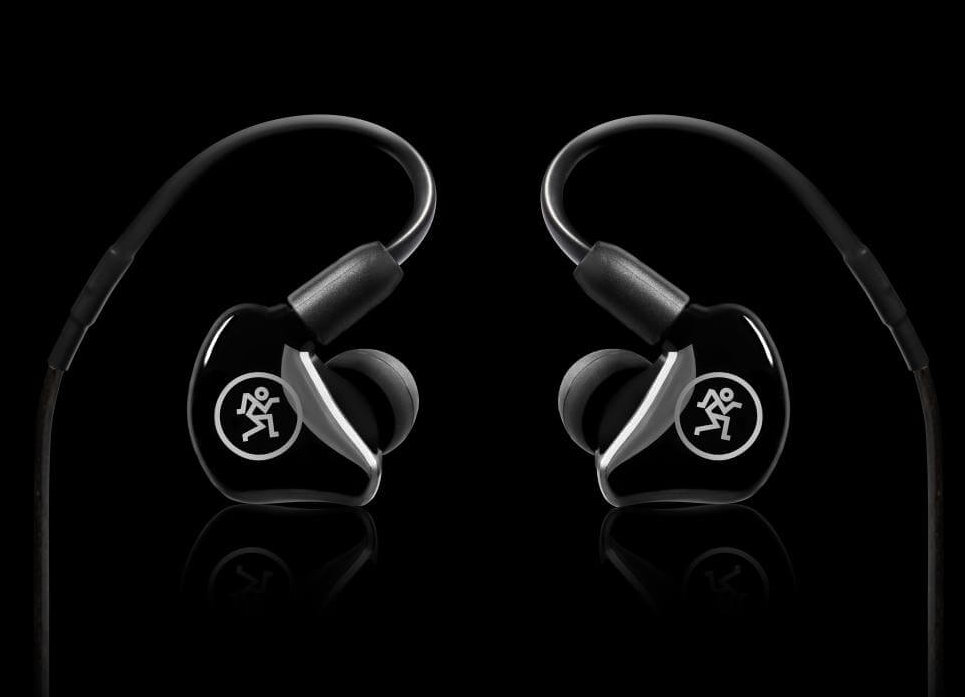Read our expert review of the new MP Series in-ear monitors from Mackie.
Along with the MBD series of DI boxes, Mackie also unveiled a new lineup of in-ear monitors at NAMM, which we’ve just had the pleasure of testing out here at Performer HQ.
For our purposes, we tested each model in the range, starting with the MP-120’s all the way through the flagship MP-240’s, in two separate situations: first as part of a recording setup for mix monitoring, and separately through a PA system to test out their capabilities through a simulated stage experience.
First impressions – if I had to guess the price point on each of these, I probably would have been way off. The MP-120’s debut at just $99 per pair, which means everyone in the band can afford them for the road. And their performance certainly belies their cost. I would have pegged these easily at $199. Bass response was tight, highs were articulate and there was no overly-aggressive mid-range hump that has plagued some other pairs of IEM’s we’ve tested over the years. Fit and comfort was great, as well (that goes for each pair), as Mackie thoughtfully provides a full range of different types and sizes of ear cushions to choose from (all housed in a nice carrying case, I might add). Rounding out the physical attributes are pro-quality detachable, braided/shielded cables. Nice.
The real test was with vocals – the main reason you might want to try IEM’s for your next tour. While bass response is important, we’re more interested in practical matters. And put simply, if you can’t hear your singer on stage (or worse, they can’t hear themselves), the whole operation is in jeopardy. So rather than focus on bass, which we’d normally do for studio monitors, we focused on vocal clarity and upper mid-to-high clarity and balance.
As we mentioned, the MP-120’s fared surprisingly well in all of our tests (both on recordings and with a PA), with vocal clarity coming through in spades. With IEM’s, you don’t have to worry much about lousy room acoustics or crummy house wedges if you’re getting a decent feed from the FOH board and whatever wireless transmitter/receiver you’re using.
But the MP-220’s were a notable step up, balance-wise. With two drivers powering each of the 220’s, you can definitely sense a lift in overall response and dynamics compared to the entry-level 120’s. That’s not to say the 120’s are bad; in fact, kudos to Mackie on delivering such good results for just $99. But judging them against the others in the range, you can see where the added expense goes for the 220’s and 240’s.
Speaking of the 240’s, they might just be the best value of the bunch (even at the highest price point). For just $199, they’re very competitively priced against other makers’ flagship IEMs, delivering crystal clear, high-powered audio with a clever hybrid design. You see, instead of the two dynamic drivers like those powering the MP-220’s, the 240’s are configured with one dynamic driver and a balanced armature driver with a proprietary crossover, sending the right frequency signals to the appropriate driver for perfect balance. Think of it as an automated mini-version of the crossover knob on the back of your subwoofer. The difference is sometimes subtle, but also immediate in A/B testing. Bass response was better (which is great, don’t get us wrong), but where things took an instant shine were in the upper registers and with vocals sitting perfectly in a real-world mix. It’s that little boost in clarity and frequency balance/distribution that lifted these above the 220’s and justifies the added $50 per pair. Well worth it, if you ask us (and since you’re reading this, we suppose you did ask us, in a way).
What’s nice about all the models is that they offer pretty reasonable isolation (which is perfect for stage or studio use), they’re all built well, are comfy to wear and all come with nice hard protective cases. If you’ve got the budget, we say take the plunge and go directly for the 240’s, you won’t be disappointed. Likewise, if budget is tight, you could outfit your entire lineup with sets of the 120’s or 220’s and be ready to hit the road.
PROS:
Great sound, well-designed, nice carrying cases. Double as audiophile in-ears (MP-240’s)
CONS:
None.
